Forecasts of MJO during DYNAMO in a Coupled Tropical Channel Model: Impact of Planetary Boundary Layer Schemes
Abstract
:1. Introduction
2. Model and Data
3. Results
3.1. MJO Events
3.1.1. MJO Precipitation
3.1.2. MJO Phase
3.2. Background Fields
3.2.1. Horizontal Structure
3.2.2. Vertical Structure
3.3. MSE Budget
3.4. Meridional Wind and Specific Humidity
4. Summary and Discussion
Author Contributions
Funding
Institutional Review Board Statement
Informed Consent Statement
Data Availability Statement
Acknowledgments
Conflicts of Interest
References
- Madden, R.A.; Julian, P.R. Detection of a 40–50 Day Oscillation in the Zonal Wind in the Tropical Pacific. J. Atmos. Sci. 1971, 28, 702–708. [Google Scholar] [CrossRef]
- Madden, R.A.; Julian, P.R. Description of Global-Scale Circulation Cells in the Tropics with a 40–50 Day Period. J. Atmos. Sci. 1972, 29, 1109–1123. [Google Scholar] [CrossRef]
- Wang, B.; Chen, G.; Liu, F. Diversity of the Madden-Julian Oscillation. Sci. Adv. 2019, 5, eaax0220. [Google Scholar] [CrossRef] [PubMed] [Green Version]
- Maloney, E.D.; Sobel, A.H. Surface fluxes and ocean coupling in the tropical intraseasonal oscillation. J. Clim. 2004, 17, 4368–4386. [Google Scholar] [CrossRef] [Green Version]
- Sobel, A.; Maloney, E.D.; Bellon, G.; Dargan, M.F. The role of surface heat fluxes in tropical intraseasonal oscillations. Nat. Geosci. 2008, 1, 653–657. [Google Scholar] [CrossRef]
- Hsu, H.H.; Lee, M.Y. Topographic effects on the eastward propagation and initiation of the Madden-Julian oscillation. J. Clim. 2005, 18, 795–809. [Google Scholar] [CrossRef]
- Adames, A.F.; Kim, D. The MJO as a dispersive, convectively coupled moisture wave: Theory and observations. J. Atmos. Sci. 2016, 73, 913–941. [Google Scholar] [CrossRef]
- Feng, J.; Li, T.; Zhu, W. Propagating and nonpropagating MJO events over maritime continent. J. Clim. 2015, 28, 8430–8449. [Google Scholar] [CrossRef]
- Kim, H.M.; Kim, D.; Vitart, F.; Toma, V.E.; Kug, J.S.; Webster, P.J. MJO propagation across the Maritime Continent in the ECMWF ensemble prediction system. J. Clim. 2016, 29, 3973–3988. [Google Scholar] [CrossRef]
- Adames, Á.F.; Wallace, J.M. Three-dimensional structure and evolution of the MJO and its relation to the mean flow. J. Atmos. Sci. 2014, 71, 2007–2026. [Google Scholar] [CrossRef]
- Muhammad, F.R.; Lubis, S.W.; Setiawan, S. Impacts of the Madden–Julian oscillation on precipitation extremes in Indonesia. Int. J. Climatol. 2021, 41, 1970–1984. [Google Scholar] [CrossRef]
- Fathurochman, I.; Lubis, S.W.; Setiawan, S. Impact of Madden-Julian Oscillation (MJO) on Global Distribution of Total Water Vapor and Column Ozone. IOP Conf. Ser. Earth Environ. Sci. 2017, 54, 012034. [Google Scholar] [CrossRef]
- Ungerovich, M.; Barreiro, M.; Masoller, C. Influence of Madden–Julian Oscillation on extreme rainfall events in Spring in southern Uruguay. Int. J. Climatol. 2021, 41, 3339–3351. [Google Scholar] [CrossRef]
- Tang, Y.; Yu, B. MJO and its relationship to ENSO. J. Geophys. Res. Atmos. 2008, 113, 1–18. [Google Scholar] [CrossRef]
- Lee, R.W.; Woolnough, S.J.; Charlton-Perez, A.J.; Vitart, F. ENSO Modulation of MJO Teleconnections to the North Atlantic and Europe. Geophys. Res. Lett. 2019, 46, 13535–13545. [Google Scholar] [CrossRef] [Green Version]
- Chen, G.; Ling, J.; Li, C.; Zhang, Y.; Zhang, C. Barrier effect of the indo-pacific maritime continent on MJO propagation in observations and CMIP5 models. J. Clim. 2020, 33, 12. [Google Scholar] [CrossRef] [Green Version]
- Zhang, C.; Ling, J. Barrier effect of the Indo-Pacific Maritime Continent on the MJO: Perspectives from tracking MJO precipitation. J. Clim. 2017, 30, 3439–3459. [Google Scholar] [CrossRef]
- Ahn, M.S.; Kim, D.; Kang, D.; Lee, J.; Sperber, K.R.; Gleckler, P.J.; Jiang, X.; Ham, Y.G.; Kim, H. MJO Propagation Across the Maritime Continent: Are CMIP6 Models Better Than CMIP5 Models? Geophys. Res. Lett. 2020, 47, 1–9. [Google Scholar] [CrossRef]
- Ling, J.; Zhang, C.; Joyce, R.; Xie, P.P.; Chen, G. Possible Role of the Diurnal Cycle in Land Convection in the Barrier Effect on the MJO by the Maritime Continent. Geophys. Res. Lett. 2019, 46, 3001–3011. [Google Scholar] [CrossRef]
- Seo, K.H.; Wang, W.; Gottschalck, J.; Zhang, Q.; Schemm, J.K.E.; Higgins, W.R.; Kumar, A. Evaluation of MJO forecast skill from several statistical and dynamical forecast models. J. Clim. 2010, 22, 2372–2388. [Google Scholar] [CrossRef]
- Ahn, M.S.; Kim, D.; Sperber, K.R.; Kang, I.S.; Maloney, E.; Waliser, D.; Hendon, H. MJO simulation in CMIP5 climate models: MJO skill metrics and process-oriented diagnosis. Clim. Dyn. 2017, 49, 4023–4045. [Google Scholar] [CrossRef] [Green Version]
- Lubis, S.W.; Jacobi, C. The modulating influence of convectively coupled equatorial waves (CCEWs) on the variability of tropical precipitation. Int. J. Climatol. 2015, 35, 1465–1483. [Google Scholar] [CrossRef]
- Lubis, S.W.; Respati, M.R. Impacts of convectively coupled equatorial waves on rainfall extremes in Java, Indonesia. Int. J. Climatol. 2021, 41, 2418–2440. [Google Scholar] [CrossRef]
- Peatman, S.C.; Schwendike, J.; Birch, C.E.; Marsham, J.H.; Matthews, A.J.; Yang, G. A Local-to-Large Scale View of Maritime Continent Rainfall: Control by ENSO, MJO, and Equatorial Waves. J. Clim. 2021, 34, 8933–8953. [Google Scholar] [CrossRef]
- Sakaeda, N.; Kiladis, G.; Dias, J. The Diurnal Cycle of Rainfall and the Convectively Coupled Equatorial Waves over the Maritime Continent. J. Clim. 2020, 33, 3307–3331. [Google Scholar] [CrossRef]
- Sobel, A.; Maloney, E. An idealized semi-empirical framework for modeling the Madden-Julian oscillation. J. Atmos. Sci. 2012, 69, 1691–1705. [Google Scholar] [CrossRef]
- Maloney, E.D. The moist static energy budget of a composite tropical intraseasonal oscillation in a climate model. J. Clim. 2009, 22, 711–729. [Google Scholar] [CrossRef] [Green Version]
- Wang, L.; Li, T.; Maloney, E.; Wang, B. Fundamental causes of propagating and nonpropagating MJOs in MJOTF/GASS models. J. Clim. 2017, 30, 3743–3769. [Google Scholar] [CrossRef]
- Wang, L.; Li, T. Effect of vertical moist static energy advection on MJO eastward propagation: Sensitivity to analysis domain. Clim. Dyn. 2020, 54, 2029–2039. [Google Scholar] [CrossRef]
- Jiang, X.; Adames, A.F.; Kim, D.; Maloney, E.; Lin, H.; Kim, H.; Zhang, C.; DeMott, C.; Klingaman, N. Fifty Years of Research on the Madden-Julian Oscillation: Recent Progress, Challenges, and Perspectives. J. Geophys. Res. Atmos. 2020, 125, e2019JD030911. [Google Scholar] [CrossRef]
- Hsu, P.C.; Li, T. Role of the boundary layer moisture asymmetry in causing the eastward propagation of the Madden-Julian oscillation. J. Clim. 2012, 25, 4914–4931. [Google Scholar] [CrossRef] [Green Version]
- Hu, X.M.; Nielsen-Gammon, J.W.; Zhang, F. Evaluation of three planetary boundary layer schemes in the WRF model. J. Appl. Meteorol. Climatol. 2010, 49, 1831–1844. [Google Scholar] [CrossRef] [Green Version]
- Yang, Y.M.; Wang, B. Improving MJO simulation by enhancing the interaction between boundary layer convergence and lower tropospheric heating. Clim. Dyn. 2019, 52, 4671–4693. [Google Scholar] [CrossRef]
- Yoneyama, K.; Zhang, C.; Long, C.N. Tracking pulses of the Madden-Julian oscillation. Bull. Am. Meteorol. Soc. 2013, 94, 1871–1891. [Google Scholar] [CrossRef]
- Tseng, K.C.; Sui, C.H.; Li, T. Moistening processes for Madden-Julian oscillations during DYNAMO/CINDY. J. Clim. 2015, 28, 3041–3057. [Google Scholar] [CrossRef]
- Jia, X.; Li, C.; Ling, J.; Zhang, C. Impacts of a GCM’s resolution on MJO simulation. Adv. Atmos. Sci. 2008, 25, 139–156. [Google Scholar] [CrossRef]
- Hu, Y.; Wang, X.; Luo, J.J.; Wang, D.; Yan, H.; Yuan, C.; Lin, X. Forecasts of MJO during DYNAMO in a coupled tropical channel model, Part I: Impact of parameterization schemes. Int. J. Climatol. 2022, 1–22. [Google Scholar] [CrossRef]
- Warner, J.C.; Armstrong, B.; He, R.; Zambon, J.B. Development of a Coupled Ocean-Atmosphere-Wave-Sediment Transport (COAWST) Modeling System. Ocean. Model. 2010, 35, 230–244. [Google Scholar] [CrossRef] [Green Version]
- Fairall, C.W.; Bradley, E.F.; Rogers, D.P.; Edson, J.B.; Young, G.S. Bulk parameterization of air-sea fluxes for Tropical Ocean-Global Atmosphere Coupled-Ocean Atmosphere Response Experiment. J. Geophys. Res. 1996, 101, 3747–3764. [Google Scholar] [CrossRef]
- Ray, P.; Zhang, C.; Dudhia, J.; Chen, S.S. A numerical case study on the initiation of the Madden-Julian oscillation. J. Atmos. Sci. 2009, 66, 310–331. [Google Scholar] [CrossRef]
- Cummings, J.A. Operational multivariate ocean data assimilation. Q. J. R. Meteorol. Soc. 2006, 131, 3583–3604. [Google Scholar] [CrossRef] [Green Version]
- Mun, J.; Lee, H.W.; Jeon, W.; Lee, S.H. Impact of meteorological initial input data on WRF simulation-comparison of ERA-interim and fnl data. J. Environ. Sci. Int. 2017, 26, 1307–1319. [Google Scholar] [CrossRef]
- Grenier, H.; Bretherton, C.S. A moist PBL parameterization for large-scale models and its application to subtropical cloud-topped marine boundary layers. Mon. Weather Rev. 2001, 129, 357–377. [Google Scholar] [CrossRef] [Green Version]
- Mellor, G.L.; Yamada, T. A Hierarchy of Turbulence Closure Models for Planetary Boundary Layers. J. Atmos. Sci. 1974, 31, 1791–1806. [Google Scholar] [CrossRef] [Green Version]
- Mellor, G.L.; Yamada, T. Development of a turbulence closure model for geophysical fluid problems. Rev. Geophys. 1982, 20, 851–875. [Google Scholar] [CrossRef] [Green Version]
- Janjic, Z.I. The step-mountain eta coordinate model: Further developments of the convection, viscous sublayer, and turbulence closure schemes. Mon. Weather Rev. 1994, 122, 927–945. [Google Scholar] [CrossRef] [Green Version]
- Hong, S.Y.; Noh, Y.; Dudhia, J. A new vertical diffusion package with an explicit treatment of entrainment processes. Mon. Weather Rev. 2006, 134, 2318–2341. [Google Scholar] [CrossRef] [Green Version]
- Tiedtke, M. A comprehensive mass flux scheme for cumulus parameterization in large-scale models. Mon. Weather Rev. 1989, 117, 1779–1800. [Google Scholar] [CrossRef] [Green Version]
- Hong, S.Y.; Dudhia, J.; Chen, S.H. A revised approach to ice microphysical processes for the bulk parameterization of clouds and precipitation. Mon. Weather Rev. 2004, 132, 103–120. [Google Scholar] [CrossRef]
- Monin, A.S.; Obukhov, A.M. Basic laws of turbulent mixing in the surface layer of the atmosphere. Contrib. Geophys. Inst. Acad. Sci. USSR 1954, 24, e187. [Google Scholar]
- Mlawer, E.J.; Taubman, S.J.; Brown, P.D.; Iacono, M.J.; Clough, S.A. Radiative transfer for inhomogeneous atmospheres: RRTM, a validated correlated-k model for the longwave. J. Geophys. Res. Atmos. 1997, 102, 16663–16682. [Google Scholar] [CrossRef] [Green Version]
- Chou, M.D.; Suarez, M. A Solar Radiation Parameterization (CLIRAD-SW) for Atmospheric Studies. NASA Tech. Memo. 1999, 15, 10460. Available online: https://www.researchgate.net/publication/237129013_A_solar_radiation_parameterization_CLIR-AD-SW_for_atmospheric_studies (accessed on 12 March 2022).
- Chen, F.; Dudhia, J. Coupling and advanced land surface-hydrology model with the Penn State-NCAR MM5 modeling system. Part I: Model implementation and sensitivity. Mon. Weather Rev. 2001, 129, 569–585. [Google Scholar] [CrossRef] [Green Version]
- Large, W.G.; McWilliams, J.C.; Doney, S.C. Oceanic vertical mixing: A review and a model with a nonlocal boundary layer parameterization. Rev. Geophys. 1994, 32, 363–403. [Google Scholar] [CrossRef] [Green Version]
- Huffman, G.J.; Adler, R.F.; Bolvin, D.T.; Nelkin, E.J. The TRMM multi-satellite precipitation analysis (TMPA). In Satellite Rainfall Applications for Surface Hydrology; Springer: Dordrecht, The Netherlands, 2010; pp. 1–19. [Google Scholar] [CrossRef] [Green Version]
- Hersbach, H.; Bell, B.; Berrisford, P.; Hirahara, S.; Horányi, A.; Muñoz-Sabater, J.; Nicolas, J.; Peubey, C.; Radu, R.; Schepers, D.; et al. The ERA5 global reanalysis. Q. J. R. Meteorol. Soc. 2020, 146, 1999–2049. [Google Scholar] [CrossRef]
- Liebmann, B.; Smith, C.A. Description of a Complete (Interpolated) Outgoing Longwave Radiation Dataset. Bull. Am. Meteorol. Soc. 1996, 77, 1275–1277. [Google Scholar]
- Moum, J.N.; De Szoeke, S.P.; Smyth, W.D.; Edson, J.B.; DeWitt, H.L.; Moulin, A.J.; Thompson, E.J.; Zappa, C.J.; Rutledge, S.A.; Johnson, R.H.; et al. Air-sea interactions from westerly wind bursts during the november 2011 MJO in the Indian Ocean. Bull. Am. Meteorol. Soc. 2014, 95, 1185–1199. [Google Scholar] [CrossRef]
- Kiladis, G.N.; Dias, J.; Straub, K.H.; Wheeler, M.C.; Tulich, S.N.; Kikuchi, K.; Weickmann, K.M.; Ventrice, M.J. A comparison of OLR and circulation-based indices for tracking the MJO. Mon. Weather Rev. 2014, 142, 1697–1715. [Google Scholar] [CrossRef]
- Hsu, P.C.; Li, T.; Murakami, H. Moisture asymmetry and MJO eastward propagation in an aquaplanet general circulation model. J. Clim. 2014, 27, 8747–8760. [Google Scholar] [CrossRef]
- Ulate, M.; Zhang, C.; Dudhia, J. Role of water vapor and convection-circulation decoupling in MJO simulations by a tropical channel model. J. Adv. Model. Earth Syst. 2015, 7, 692–711. [Google Scholar] [CrossRef] [Green Version]
- Ulate, M.; Dudhia, J.; Zhang, C. Sensitivity of the water cycle over the Indian Ocean and Maritime Continent to parameterized physics in a regional model. J. Adv. Model. Earth Syst. 2014, 6, 1095–1120. [Google Scholar] [CrossRef]
- Liu, P.; Wang, B.; Sperber, K.R.; Li, T.; Meehl, G.A. MJO in the NCAR CAM2 with the Tiedtke convective scheme. J. Clim. 2005, 18, 3007–3020. [Google Scholar] [CrossRef] [Green Version]
- Yano, J.I.; Ambaum, M.H.P. Moist static energy: Definition, reference constants, a conservation law and effects on buoyancy. Q. J. R. Meteorol. Soc. 2017, 143, 2727–2734. [Google Scholar] [CrossRef]
- Ruppert, J.H.; Wing, A.A.; Tang, X.; Duran, E.L. The critical role of cloud–infrared radiation feedback in tropical cyclone development. Proc. Natl. Acad. Sci. USA 2020, 117, 27884–27892. [Google Scholar] [CrossRef]
- Neelin, J.D.; Held, I.M. Modeling tropical convergence based on the moist static energy budget. Mon. Weather Rev. 1987, 115, 3–12. [Google Scholar] [CrossRef]
- Zhang, C.; Adames, F.; Khouider, B.; Wang, B.; Yang, D. Four theories of the Madden-julian Oscillation. Rev. Geophys. 2020, 58, e2019RG000685. [Google Scholar] [CrossRef]
- Wang, B.; Liu, F.; Chen, G. A trio-interaction theory for Madden–Julian oscillation. Geophys. Lett. 2016, 3, 34. [Google Scholar] [CrossRef] [Green Version]
- Huang, W.Y.; Shen, X.Y.; Wang, W.G.; Huang, W. Comparison of the thermal and dynamic structural characteristics in boundary layer with different boundary layer parameterizations. Chin. J. Geophys.-Ch. 2014, 57, 543–562. [Google Scholar] [CrossRef]
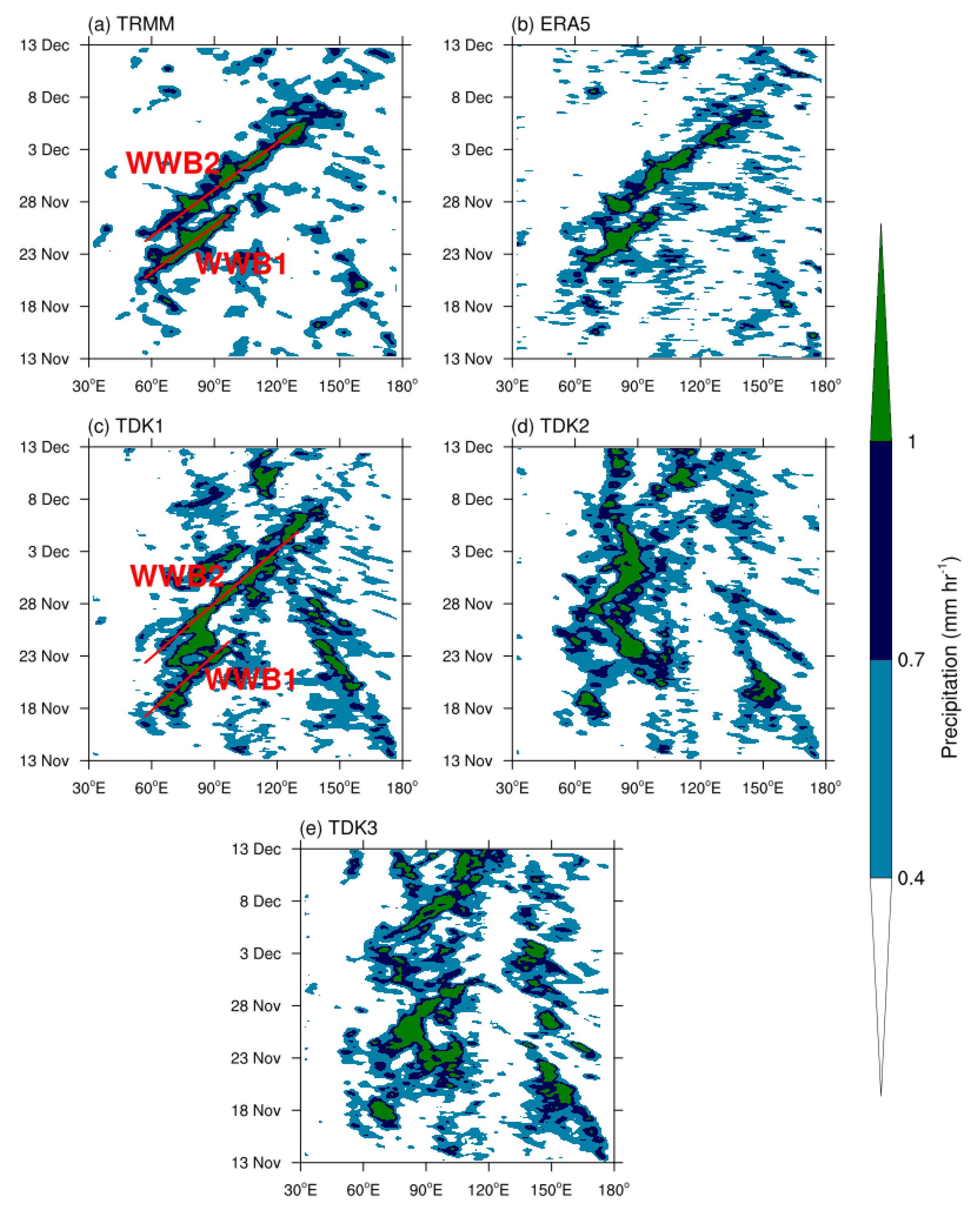
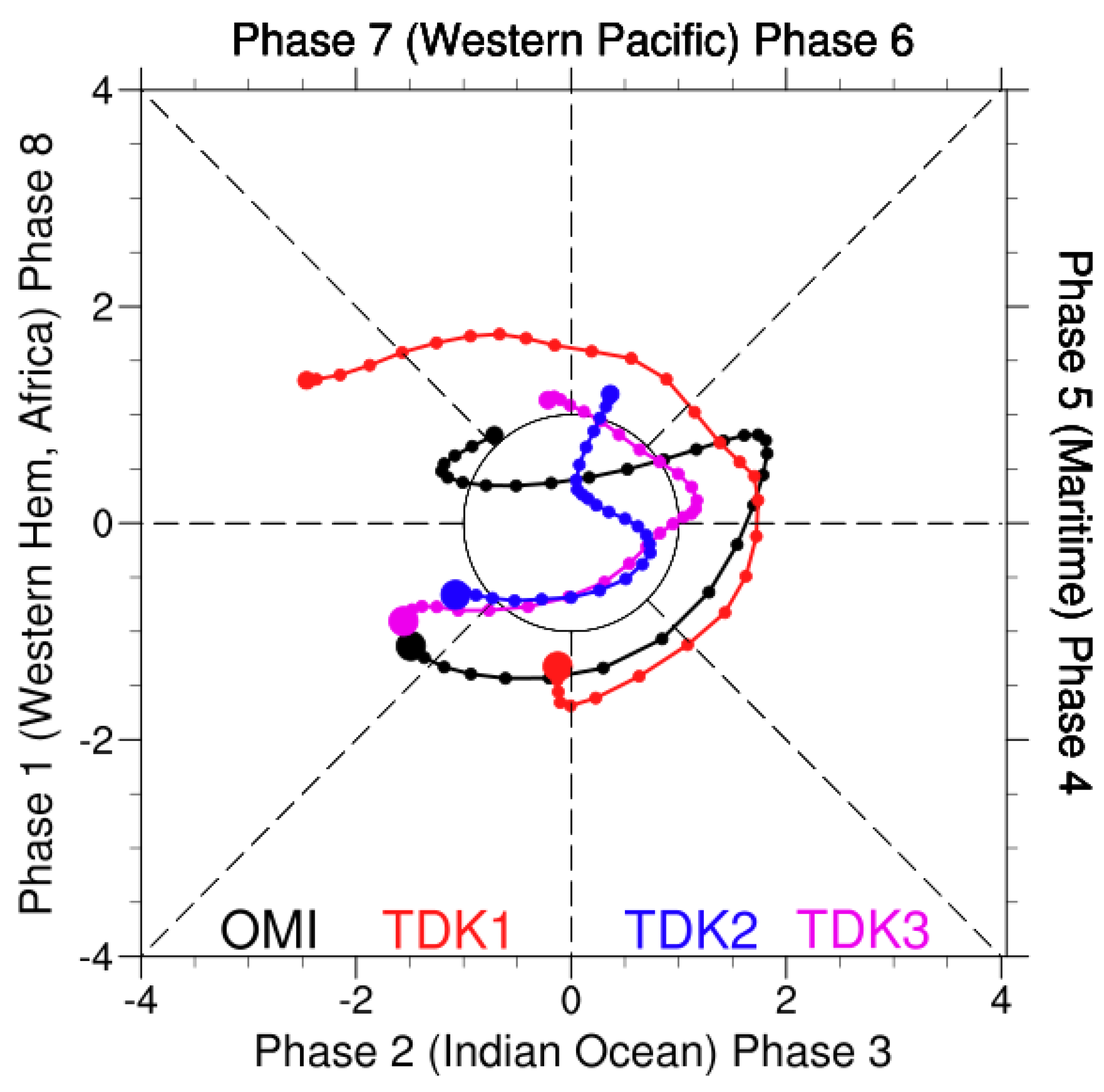

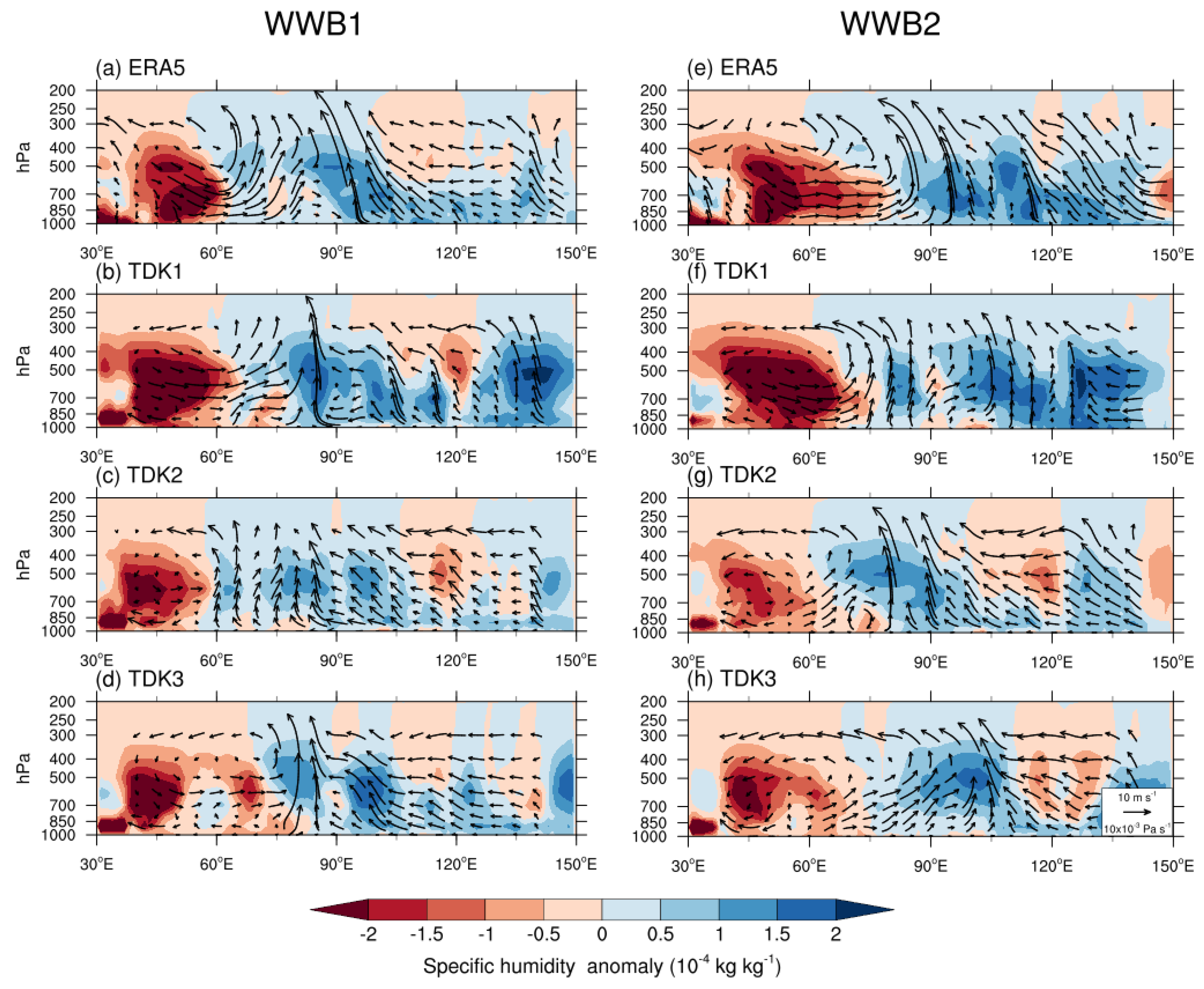
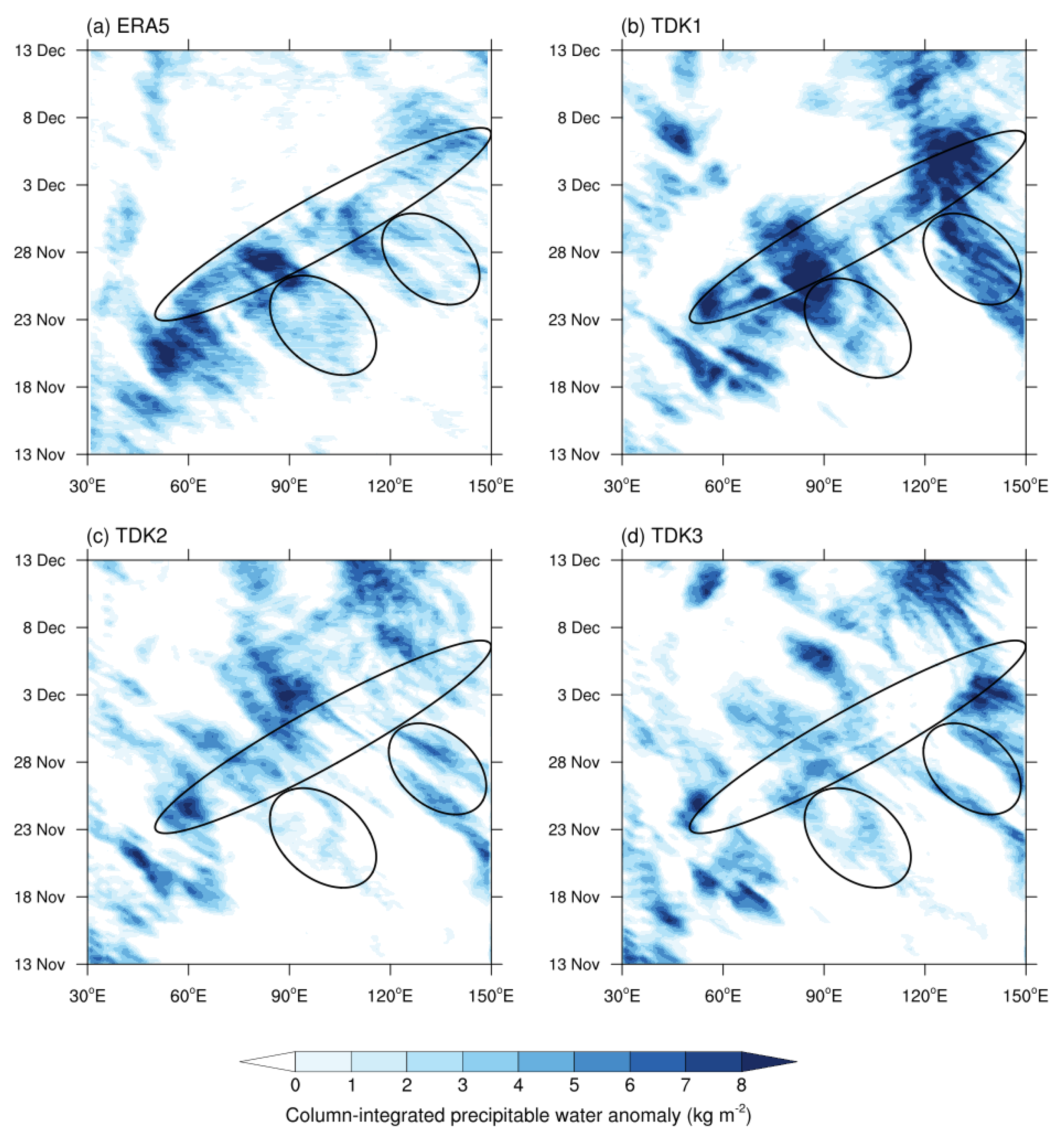
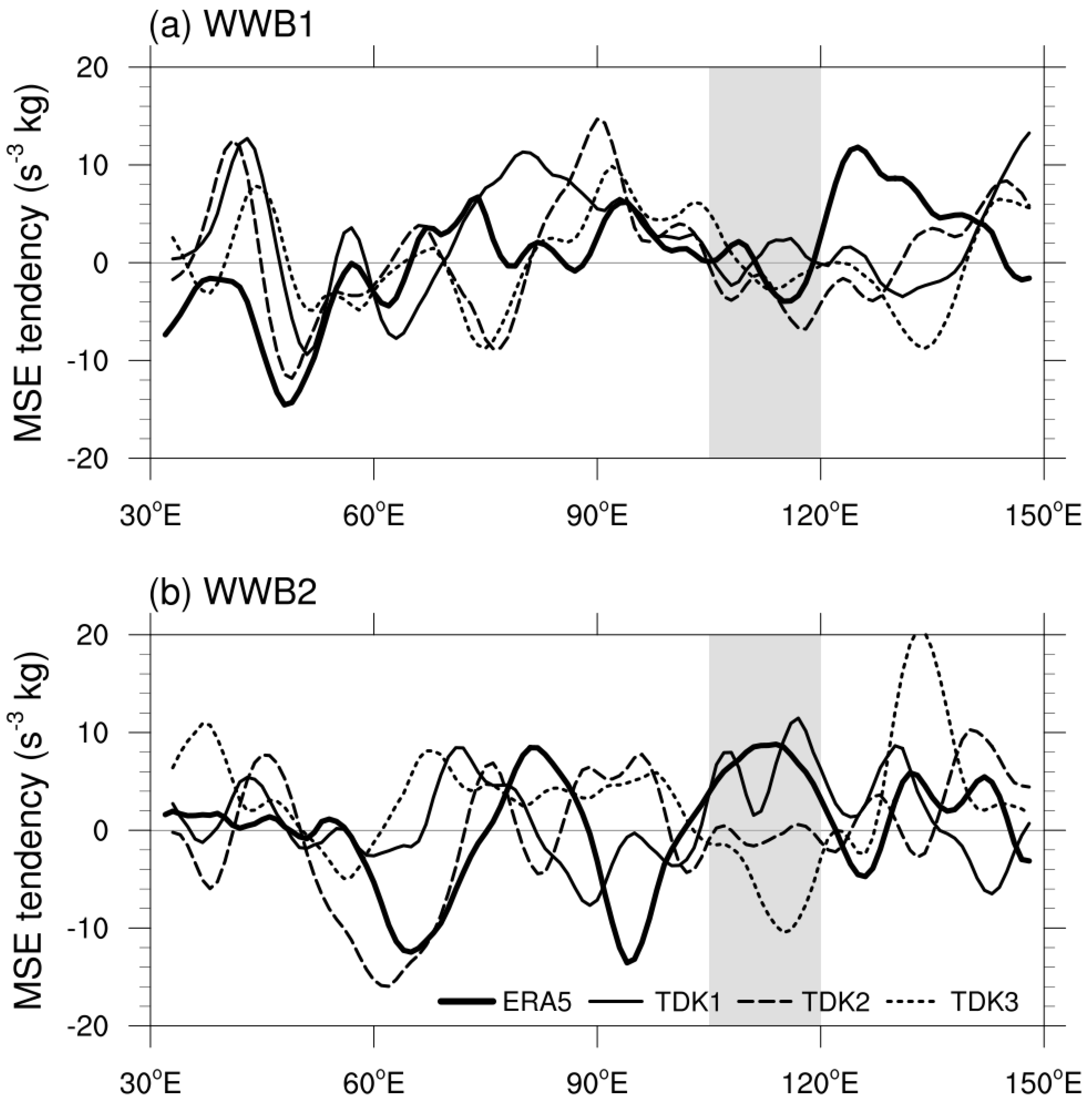
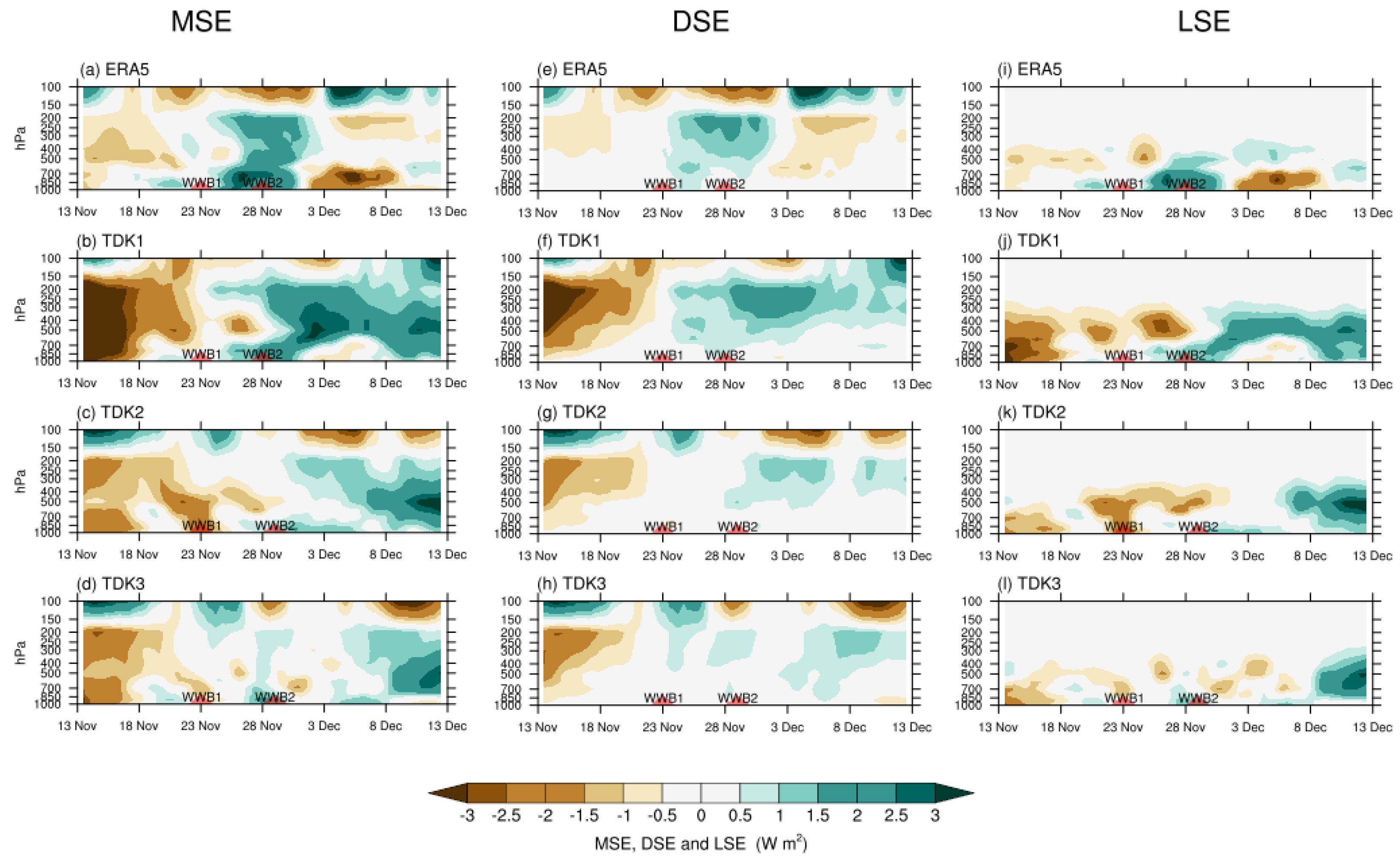
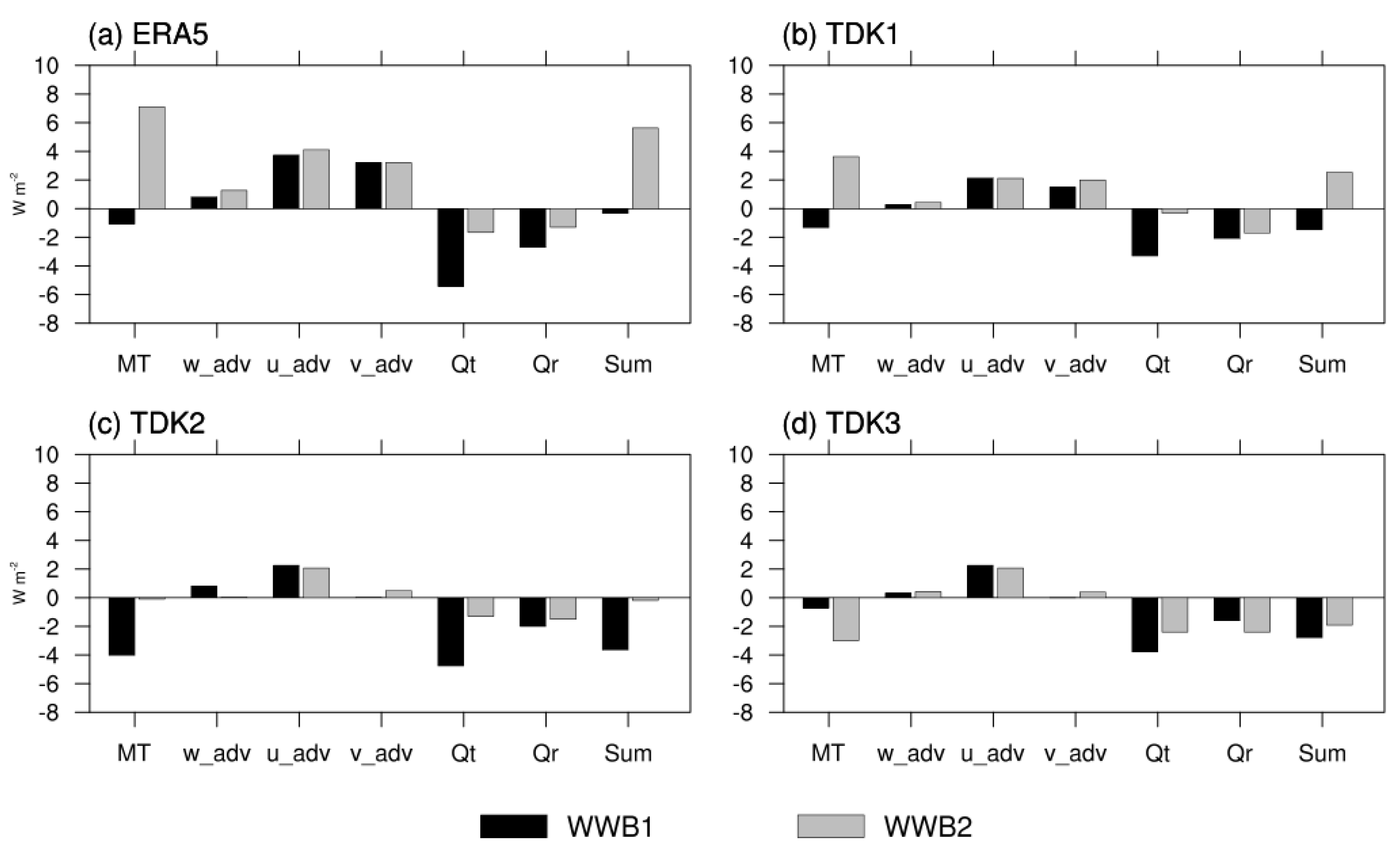
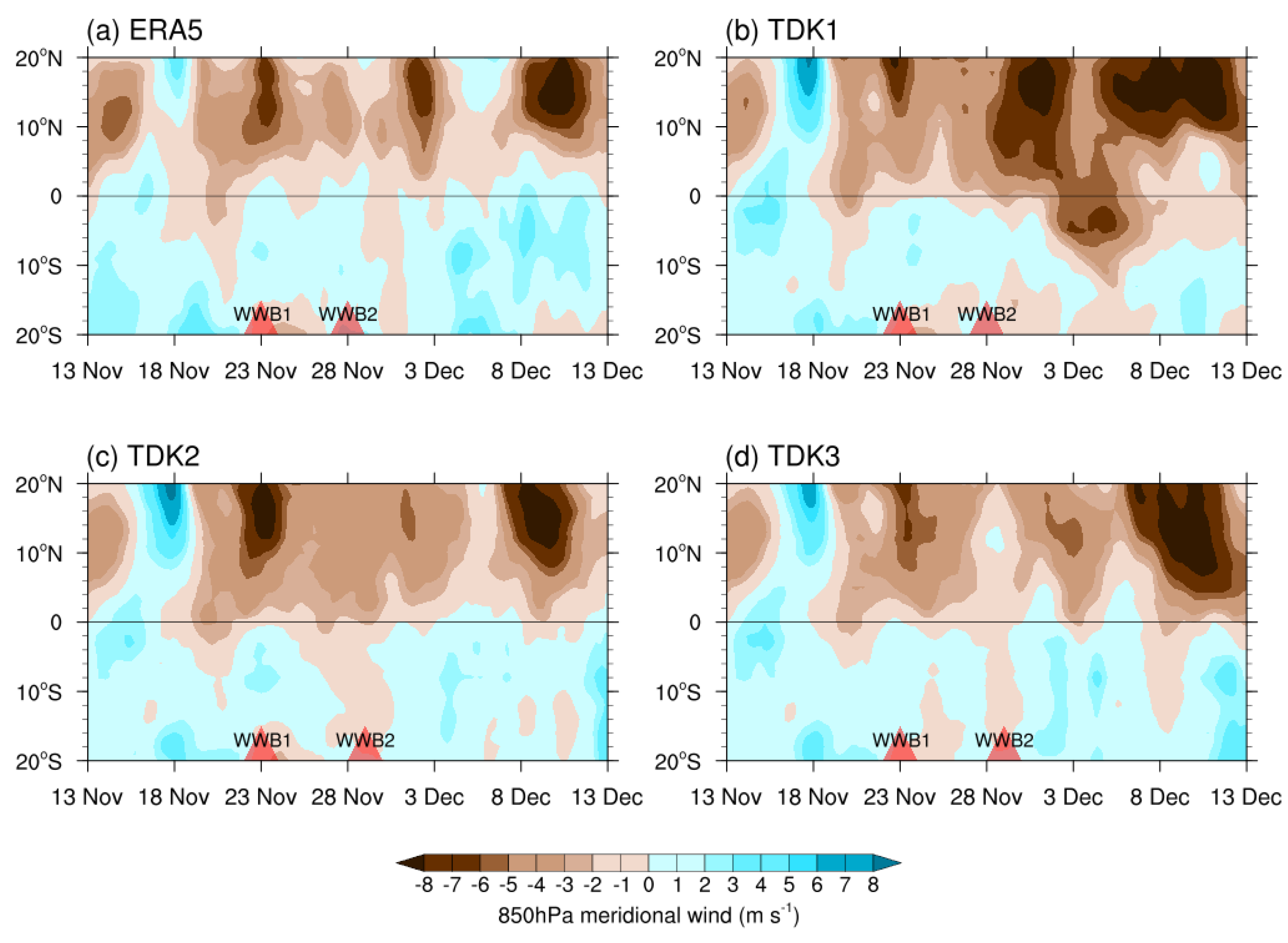
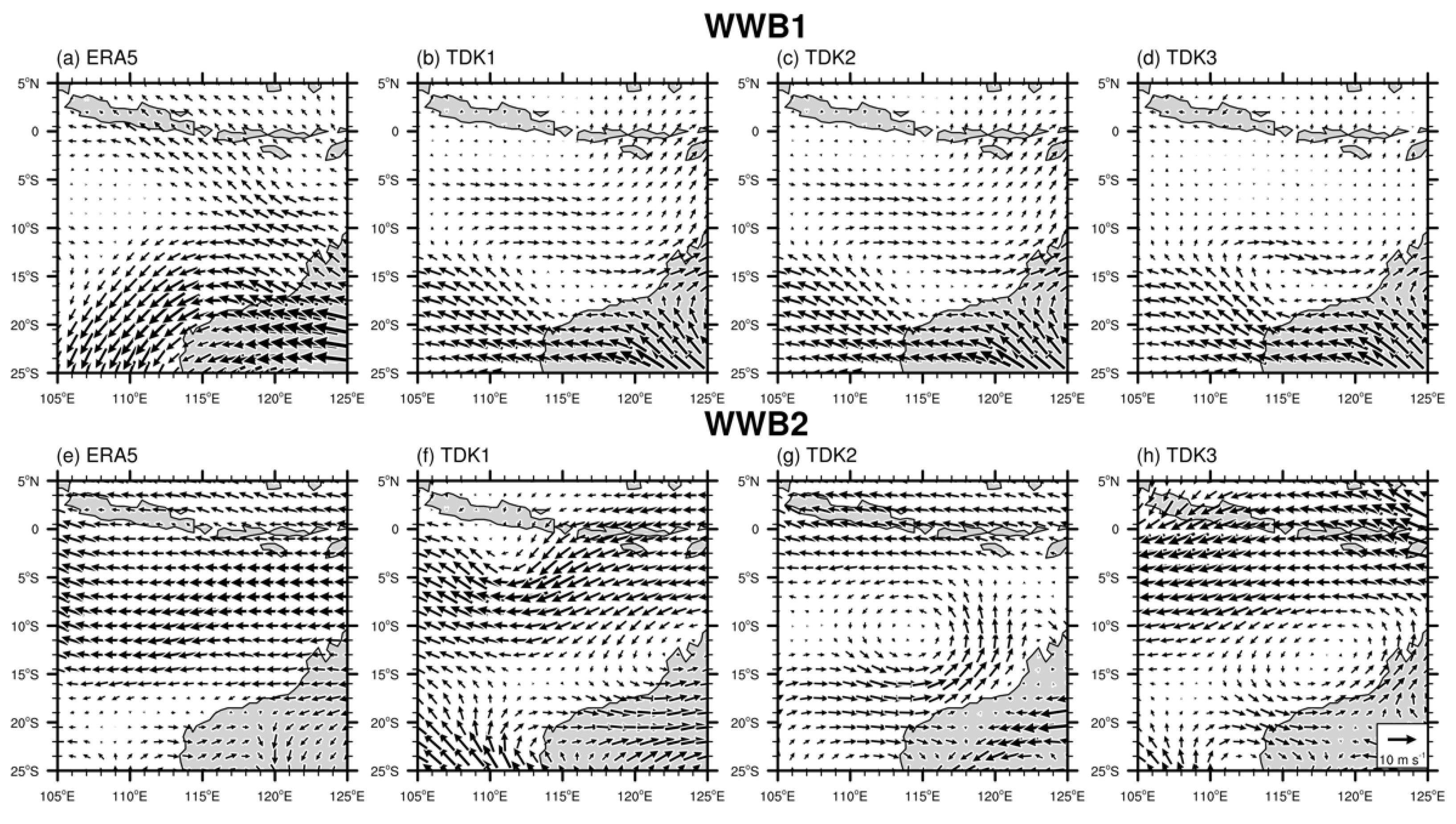

Publisher’s Note: MDPI stays neutral with regard to jurisdictional claims in published maps and institutional affiliations. |
© 2022 by the authors. Licensee MDPI, Basel, Switzerland. This article is an open access article distributed under the terms and conditions of the Creative Commons Attribution (CC BY) license (https://creativecommons.org/licenses/by/4.0/).
Share and Cite
Hu, Y.; Wang, X.; Luo, J.-J.; Wang, D.; Yan, H.; Yuan, C.; Lin, X. Forecasts of MJO during DYNAMO in a Coupled Tropical Channel Model: Impact of Planetary Boundary Layer Schemes. Atmosphere 2022, 13, 666. https://doi.org/10.3390/atmos13050666
Hu Y, Wang X, Luo J-J, Wang D, Yan H, Yuan C, Lin X. Forecasts of MJO during DYNAMO in a Coupled Tropical Channel Model: Impact of Planetary Boundary Layer Schemes. Atmosphere. 2022; 13(5):666. https://doi.org/10.3390/atmos13050666
Chicago/Turabian StyleHu, Yun, Xiaochun Wang, Jing-Jia Luo, Dongxiao Wang, Huiping Yan, Chaoxia Yuan, and Xia Lin. 2022. "Forecasts of MJO during DYNAMO in a Coupled Tropical Channel Model: Impact of Planetary Boundary Layer Schemes" Atmosphere 13, no. 5: 666. https://doi.org/10.3390/atmos13050666
APA StyleHu, Y., Wang, X., Luo, J.-J., Wang, D., Yan, H., Yuan, C., & Lin, X. (2022). Forecasts of MJO during DYNAMO in a Coupled Tropical Channel Model: Impact of Planetary Boundary Layer Schemes. Atmosphere, 13(5), 666. https://doi.org/10.3390/atmos13050666





